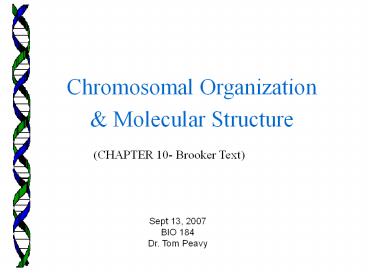Brooker Chapter 10 PowerPoint PPT Presentation
Title: Brooker Chapter 10
1
Chromosomal Organization Molecular Structure
(CHAPTER 10- Brooker Text)
Sept 13, 2007 BIO 184 Dr. Tom Peavy
2
Prokaryotic vs. Eukaryotic
What are the essential differences? How
would this impact chromosome organization?
3
- To fit within the bacterial cell, the chromosomal
DNA must be compacted about a 1000-fold - This involves the formation of loop domains
The looped structure compacts the chromosome
about 10-fold
Figure 10.5
4
- DNA supercoiling is a second important way to
compact the bacterial chromosome
Supercoiling within loops creates a more compact
DNA
Figure 10.6
5
- The control of supercoiling in bacteria is
accomplished by two main enzymes - 1. DNA gyrase (also termed DNA topoisomerase II)
- Introduces negative supercoils using energy from
ATP - It can also relax positive supercoils when they
occur - 2. DNA topoisomerase I
- Relaxes negative supercoils
- The competing action of these two enzymes governs
the overall supercoiling of bacterial DNA
6
EUKARYOTIC CHROMOSOMES
- Eukaryotic genomes vary substantially in size
- The difference in the size of the genome is not
because of extra genes - Rather, the accumulation of repetitive DNA
sequences - These do not encode proteins
7
Variation in Eukaryotic Genome Size
Has a genome that is more than twice as large as
that of
Figure 10.10
8
Eukaryotic Chromatin Compaction
- -Problem-
- If stretched end to end, a single set of human
chromosomes will be over 1 meter long- but cells
nucleus is only 2 to 4 µm in diameter!!! - How does the cell achieve such a degree of
chromatin compaction?
9
First Level Chromatin organized as repeating
units
Nucleosomes
- Double-stranded DNA wrapped around an octamer of
histone proteins - Connected nucleosomes resembles beads on a
string - seven-fold reduction of DNA length
10
- Histone proteins are basic
- They contain many positively-charged amino acids
- Lysine and arginine
- These bind with the phosphates along the DNA
backbone - There are five types of histones
- H2A, H2B, H3 and H4 are the core histones
- Two of each make up the octamer
- H1 is the linker histone
- Binds to linker DNA
- Also binds to nucleosomes
- But not as tightly as are the core histones
11
Second level Nucleosomes associate with each
other to form a more compact structure termed
the 30 nm fiber
- Histone H1 plays a role in this compaction
- The 30 nm fiber shortens the total length of DNA
another seven-fold - These two events compact the DNA
- 7x7 49 ( ?50 fold compaction)
12
Further Compaction of the Chromosome
- A third level of compaction involves interaction
between the 30 nm fiber and the nuclear matrix
Matrix-attachment regions
MARs are anchored to the nuclear matrix, thus
creating radial loops
13
Heterochromatin vs Euchromatin
- The compaction level of interphase chromosomes is
not completely uniform - Euchromatin
- Less condensed regions of chromosomes
- Transcriptionally active
- Regions where 30 nm fiber forms radial loop
domains - Heterochromatin
- Tightly compacted regions of chromosomes
- Transcriptionally inactive (in general)
- Radial loop domains compacted even further
14
Figure 10.20
- There are two types of heterochromatin
- Constitutive heterochromatin
- Regions that are always heterochromatic
- Permanently inactive with regard to transcription
- Facultative heterochromatin
- Regions that can interconvert between euchromatin
and heterochromatin
15
Figure 10.21
16
Compaction level in euchromatin
During interphase most chromosomal regions are
euchromatic
Compaction level in heterochromatin
Figure 10.21

